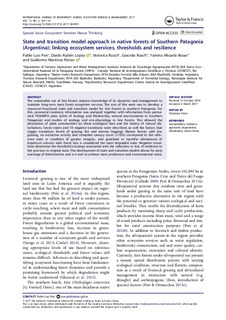| dc.contributor.author | Peri, Pablo Luis | |
| dc.contributor.author | López, Dardo Rubén | |
| dc.contributor.author | Rusch, Veronica | |
| dc.contributor.author | Rusch, Graciela | |
| dc.contributor.author | Rosas, Yamina Micaela | |
| dc.contributor.author | Pastur, Guillermo Martinéz | |
| dc.coverage.spatial | Southern Patagonia, Southern America | nb_NO |
| dc.date.accessioned | 2017-05-29T13:29:49Z | |
| dc.date.available | 2017-05-29T13:29:49Z | |
| dc.date.created | 2017-04-18T23:14:37Z | |
| dc.date.issued | 2017 | |
| dc.identifier.citation | International Journal of Biodiversity Science, Ecosystem Services & Management. 2017, 13 (2), 105-118. | nb_NO |
| dc.identifier.issn | 2151-3732 | |
| dc.identifier.uri | http://hdl.handle.net/11250/2443746 | |
| dc.description.abstract | The sustainable use of ñire forests requires knowledge of its dynamics and management to maintain long-term main forest ecosystem services. The aim of this work was to develop a structural–functional state and transition model for ñire forests in southern Patagonia. For this, provincial inventory information was analyzed together with information from permanent PEBANPA plots (plots of Ecology and Biodiversity, natural environments in Southern Patagonia) and studies of ecology and eco-physiology in ñire forests. This allowed the description of plant communities on these ecological sites and the history of natural disturbances. Seven states and 10 negative transitions were described, as well the factors that trigger transitions (levels of grazing, fire and intense logging). Mature forests with low grazing, no extractive activity and complete canopy cover (>70%) correspond to the reference state or condition of greater integrity, and grassland or murtillar (dominance of Empetrum rubrum) with forest loss is considered the most degraded state. Negative transitions determine the threshold crossings associated with the reduction or loss of resilience to the previous or original state. The development of state and transition models allows for early warnings of deterioration and is a tool to achieve more productive and environmental value. Sustainability; resilience approach; degradation; disturbance; native forest | nb_NO |
| dc.language.iso | eng | nb_NO |
| dc.rights | Navngivelse 4.0 Internasjonal | * |
| dc.rights.uri | http://creativecommons.org/licenses/by/4.0/deed.no | * |
| dc.subject | Sustainability | nb_NO |
| dc.subject | resilience approach | nb_NO |
| dc.subject | degradation | nb_NO |
| dc.subject | disturbance | nb_NO |
| dc.subject | native forest | nb_NO |
| dc.title | State and transition model approach in native forests of Southern Patagonia (Argentina): linking ecosystem services, thresholds and resilience | nb_NO |
| dc.type | Journal article | nb_NO |
| dc.type | Peer reviewed | nb_NO |
| dc.subject.nsi | VDP::Basale biofag: 470 | nb_NO |
| dc.subject.nsi | VDP::Basic biosciences: 470 | nb_NO |
| dc.source.pagenumber | 105-118 | nb_NO |
| dc.source.volume | 13 | nb_NO |
| dc.source.journal | International Journal of Biodiversity Science, Ecosystem Services & Management | nb_NO |
| dc.source.issue | 2 | nb_NO |
| dc.identifier.doi | 10.1080/21513732.2017.1304995 | |
| dc.identifier.cristin | 1465347 | |
| dc.relation.project | EU/OpenNESS | nb_NO |
| cristin.unitcode | 7511,2,0,0 | |
| cristin.unitname | Avdeling for terrestrisk økologi | |
| cristin.ispublished | true | |
| cristin.fulltext | original | |
| cristin.qualitycode | 1 | |

